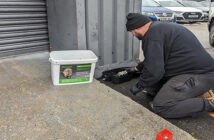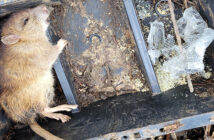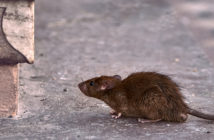Somewhere between 10 and 20% of food manufacturing premises have an endemic mouse problem and that means plenty of room for good pest control businesses to get on top of the problems.
Many of the 80 or so delegates attending the Society of Food Hygiene and Technology (SOFHT) conference and exhibition on Rodents and Rodent Control: Getting the Risks in Proportion were surprised to learn of such a level of mouse infestation.
| But, as Dr John Simmons of Acheta Consulting showed in his presentation, one of the main reasons is that, unlike other public health threats in a food manufacturing plant, mice are intelligent. They have worked out that bait boxes are not very interesting and they either avoid them or walk over them.
As a monitoring device boxes, whatever they contain, are not working as the pest control industry might expect. There is even evidence of mice entering bait boxes, with traps in them walking around the traps and exiting without triggering them. Globally respected rodent expert, Adrian Meyer, outlined how many rodenticides had already been lost to the UK pest management industry and how to best use those that are left. Dr Alan Buckle is working tirelessly to defend the remaining rodenticides which, he explained, are detested by the European Parliament, Commission and Member States. He said that these authorities are looking to remove these products from the market and would do so but for the fact that there are no alternatives. Paul Butt from Natural England reviewed the practicalities, legalities and ethics of one of the only options that might be left if Europe has its way – traps and trapping – a nice green option with no nasty chemicals involved! He pointed out that alone trapping is never going to be a complete control mechanism but it does have a role in monitoring and traps can be part of an integrated pest management (IPM) approach. Rounding off the day were two presentations on the topic of balancing the risks of rodents and their control. The first, by consultant Ian Abbotts, included a review of his experience at Nabisco when he experimented with a pesticide free pest control regime. This relied heavily on thorough inspections for pests by the employees. As well as costing more than twice the pest control contract it replaced, the system finally succumbed because of a general feeling of uneasiness amongst hygiene and quality control staff that it could actually work. In the end the factories in the experiment reverted to a toxic system with everyone agreeing it was very risky to abandon the use of toxic materials altogether. Rory Hope from Check Services gave an excellent account of how the various retailer standards governing pest control strategies can handicap sensible pest control and made a plea for flexibility within the standards to allow professional pest mangers to do their jobs. |
Exhibitors included Acheta Consulting who sponsored the event. Pictured centre, John Lloyd and right, Chris Swindells with GreenTrapOnline’s Peter Graversen
|
|
|
The associated exhibition gave delegates the opportunity to chat with pest management companies such as Check Services, Rokill, Rentokil and Pestokill, pest control businesses like Woodstream, Killgerm and GreenTrapOnline as well as bird management specialists Hawksdrift Falconry. Hawksdrift founder, Layla Bennett gave a hawk flying demonstration during the lunchtime break. Having warned her audience that the Harris hawk she was flying might choose to land on one of the audiences’ heads, the hawk promptly selected Rokill’s Paul Westgate as a suitable landing point. |
||




